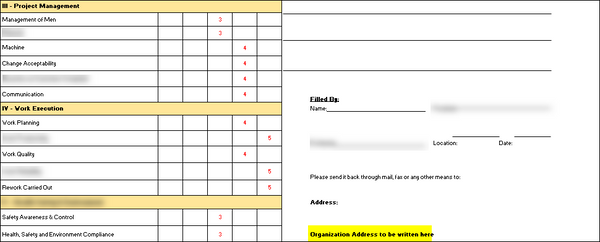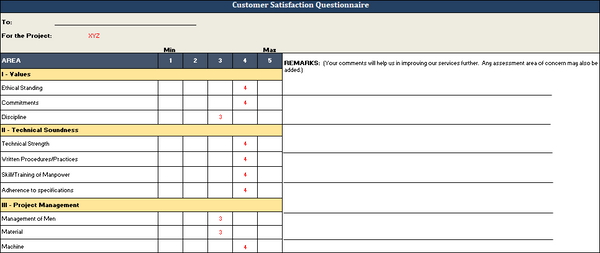ISO 9001 Customer Satisfaction Questionnaire Template
The ISO 9001 Customer Satisfaction Questionnaire Template is specifically designed to help organizations gauge the level of customer satisfaction and identify areas for improvement. By using this template, businesses can gather valuable feedback from their customers, which in turn helps them enhance their products, services, and overall customer experience. With a structured questionnaire format that is aligned with ISO 9001 quality management standard requirements, this template provides a comprehensive framework for measuring customer satisfaction and taking action to meet or exceed customer expectations.
The Importance of ISO 9001 Customer Satisfaction Questionnaire Template
ISO 9001 is an international standard that sets out the criteria for a quality management system. It is widely recognized and respected by businesses worldwide. One important aspect of ISO 9001 is the focus on customer satisfaction. By ensuring that the needs and expectations of customers are met, companies can improve their products, services, and overall customer experience.
A customer satisfaction questionnaire is a tool used to gather feedback from customers about their experience with a company. It allows businesses to assess customer satisfaction levels and identify areas for improvement. Having a standardized template for this questionnaire can be highly beneficial for several reasons:
- Consistency: Using a standardized template ensures that the same questions are asked to all customers. This allows for consistent data collection and analysis, making it easier to compare and measure customer satisfaction levels over time.
- Objectivity: A template provides a structured approach to gathering feedback, ensuring that all relevant aspects of the customer experience are covered. This helps to eliminate bias and subjectivity, allowing for a more objective assessment of customer satisfaction.
- Efficiency: A template saves time and effort by providing pre-designed questions that have been proven to be effective in assessing customer satisfaction. This eliminates the need to recreate a questionnaire from scratch and streamlines the data collection process.
- Benchmarking: By using a standardized template, companies can compare their customer satisfaction levels with industry benchmarks or their own previous performance. This allows for a better understanding of how well the company is meeting customer expectations and helps to identify areas for improvement.
- Continuous improvement: A customer satisfaction questionnaire template serves as a tool for continuous improvement. The feedback collected from customers can be used to identify trends, patterns, and areas of improvement. This information can then be used to implement changes and enhance the customer experience.
The Key Components of ISO 9001 Customer Satisfaction Questionnaire Template
- Ethical Standing: This component ensures that the company operates with integrity and adheres to ethical principles in its interactions with customers. It assesses whether the organization follows fair business practices and treats customers with honesty and respect.
- Waste Management: This component evaluates how well the company manages waste and minimizes its environmental impact. It assesses whether the organization has effective processes in place to reduce, reuse, and recycle waste, thereby demonstrating environmental responsibility.
- Bottleneck Handling Capability: This component measures the organization's ability to identify and effectively handle bottlenecks or issues that may hinder the smooth flow of products or services. It assesses whether the company has mechanisms in place to proactively identify and resolve bottlenecks, ensuring efficient operations and customer satisfaction.
- Targets Meeting Capability: This component assesses the organization's ability to meet targets and deliver products or services within agreed-upon timelines. It evaluates whether the company consistently meets customer expectations by delivering products or services on time, in the required quantity and quality, and according to agreed-upon specifications.
- Demographic Information: This section collects basic demographic information, such as the customer's age, gender, location, and occupation. This data helps companies to identify trends and patterns in customer satisfaction based on different demographic segments.
- Satisfaction Rating Scale: The questionnaire should include a satisfaction rating scale, where customers can rate their experience using a numerical scale or a Likert scale. This scale can range from extremely dissatisfied to extremely satisfied, allowing customers to express their level of satisfaction accurately.
- Questions About Product/Service: This section contains specific questions regarding the product or service the customer purchased. These questions can be related to quality, features, performance, durability, or any other relevant aspect. This allows companies to understand how well their offerings meet customer expectations.
- Questions about Customer Service: This section focuses on the customer's experience with the company's customer service representatives. Customers can provide feedback on aspects such as responsiveness, friendliness, problem resolution, and overall satisfaction with the support they received.
- Purchase Experience: This section explores the customer's experience during the purchasing process. It can include questions about ease of use, website navigation, speed of delivery, packaging, and any other relevant factors. This helps companies identify areas for improvement and streamline their purchasing process.
- Open-Ended Questions: Including open-ended questions in the questionnaire allows customers to provide qualitative feedback in their own words. This gives companies valuable insights into specific issues or suggestions that customers may have.
- Overall Satisfaction and Recommendation: The questionnaire template should conclude with questions about the customer's overall satisfaction with the product or service and their likelihood of recommending it to others. These questions provide an overall assessment of the customer's experience and help gauge their loyalty to the brand.
- Data Analysis: The template should include a section dedicated to data analysis, where companies can input the responses and calculate key metrics, such as average satisfaction scores, customer loyalty scores, and performance in different areas. This section can also contain charts or graphs to visually represent the data for easy interpretation.
- Action Plan: Finally, the questionnaire template should have a section that outlines the company's plan of action based on the feedback received. This helps ensure that customer feedback is effectively used to drive continuous improvement in the organization.

The Benefits of ISO 9001 Customer Satisfaction Questionnaire Template
- Standardization: By using an ISO 9001 customer satisfaction questionnaire template, organizations can ensure that the questions asked are standardized across different customers. This allows for consistent data collection and analysis, making it easier to identify trends and areas for improvement.
- Measuring customer satisfaction: The questionnaire template provides a structured approach to measuring customer satisfaction. It includes specific questions related to different aspects of the customer experience, such as product quality, customer service, and delivery times. This allows organizations to gather valuable feedback on how well they are meeting customer expectations.
- Identifying areas for improvement: The questionnaire template helps identify areas where the organization may be falling short in terms of customer satisfaction. By analyzing the responses, organizations can pinpoint common pain points or issues that need to be addressed. This information can then be used to make improvements to products, services, or processes to enhance the overall customer experience.
- Benchmarking: The use of an ISO 9001 customer satisfaction questionnaire template enables organizations to benchmark their performance against industry standards and competitors. By comparing their customer satisfaction scores or ratings with others in the same sector, organizations can gain insights into their market position and identify opportunities for differentiation.
- Customer feedback loop: When organizations regularly send out customer satisfaction questionnaires, it establishes a feedback loop with customers. This demonstrates a commitment to improving customer satisfaction and provides customers with a platform to voice their opinions. By actively seeking and acting upon customer feedback, organizations can build stronger customer relationships and loyalty.
- Compliance with ISO 9001: Implementing a customer satisfaction questionnaire template aligns with the requirements of ISO 9001, the international standard for quality management systems. ISO 9001 places a strong emphasis on customer satisfaction and continuous improvement. By using the template, organizations can demonstrate their commitment to meeting these requirements and maintaining a customer-focused approach.
Conclusion
In conclusion, the ISO 9001 Customer Satisfaction Questionnaire Template is an essential tool for businesses looking to improve their customer satisfaction levels. By using this template, companies can gather valuable feedback from their customers and identify areas for improvement. The standardized format of the questionnaire ensures that all necessary information is collected, and the customizable nature allows businesses to tailor the questionnaire to their specific needs. Overall, implementing this template can help businesses enhance their customer experience and ultimately drive their success.


